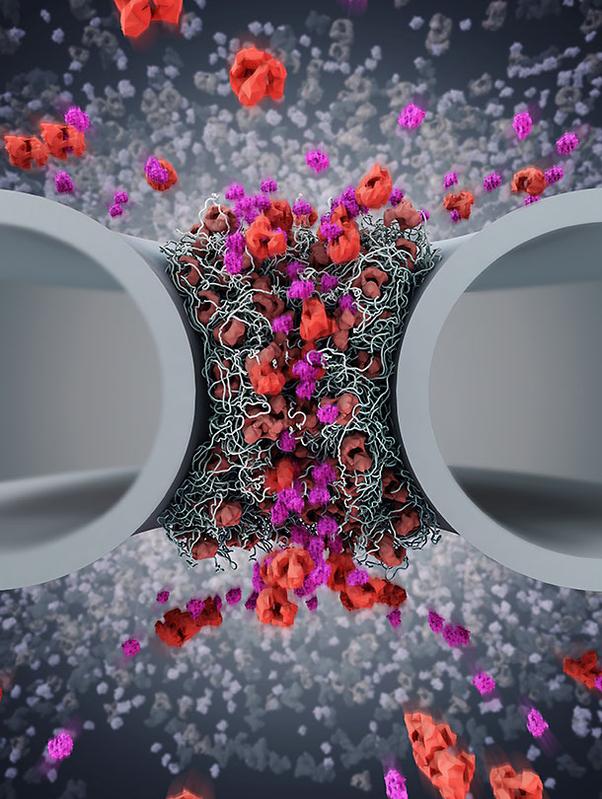Like a Revolving Door: How Shuttling Proteins Operate Nuclear Pores

Shuttling proteins at the nuclear pore – working like a revolving door. Immanuel Wagner/imma.tv
Genetic information is protected in the cell nucleus by a membrane that contains numerous nuclear pores. These pores facilitate the traffic of proteins known as importins that deliver molecular cargoes between the nucleus and the surrounding cytoplasm.
In contrast to prevailing views, the team led by Prof. Roderick Lim, Argovia Professor at the Biozentrum and the Swiss Nanoscience Institute of the University of Basel, has now demonstrated that the nuclear pore complex does not work like a simple filter that regulates the nuclear transport process. Rather, different importins cooperate to continuously open and close the pore like a “revolving door”.
Importins regulate nuclear pores
For a long time scientists have reasoned that a molecular filter within the nuclear pore complex prevents or enables the passage of molecules into the nucleus. Lim’s current study now shows that this filter alone is not sufficient for barrier function but provides only the basic infrastructure for establishing one. Instead, cargo-carrying importins function as bona fide components that regulate the nuclear pore complex transport barrier.
Moreover, Lim and colleagues show how the shuttling of importins is coupled to their barrier function. In fact, importins exist in two interacting forms: alpha and beta. Importin beta promotes cargo access into the pore whereas Importin alpha determines the cargo that can enter the nucleus.
Surprisingly, the team has now discovered that importin alpha acts as a molecular switch that helps to release or retain importin beta to open or close the pore. In the absence of importin alpha, importin beta loses its ability to shuttle through the nuclear pore channel.
Importins in health and disease
The insights provided by the study also have implications for the understanding of diseases associated with transport defects at the nuclear pore complex, such as cancer.
“We always thought of the nuclear pore complex as a standalone machine that controls nuclear transport”, says Lim.
“Now, we have a much greater appreciation for how the systematic interplay of importin alpha and beta are able to regulate the nuclear pore complex to sustain continuous transport. Hence, if importin alpha malfunctions the revolving door mechanism might get stuck such that essential proteins cannot get to their nuclear destinations. Or if importin beta is defective, the pore might become leaky against unwanted substances that can enter and poison the nucleus.”
Original article
Larisa E. Kapinos, Binlu Huang, Chantal Rencurel and Roderick Y.H. Lim
Karyopherins regulate nuclear pore complex barrier and transport function
Journal of Cell Biology (2017), doi: 10.1083/jcb.201702092
Further information
Prof. Dr. Roderick Lim, University of Basel, Biozentrum, and Swiss Nanoscience Institute, Tel. +41 61 207 20 83, E-Mail: roderick.lim@unibas.ch
Heike Sacher, University of Basel, Biozentrum, Communications, Tel. +41 61 207 14 49, email: heike.sacher@unibas.ch
https://www.unibas.ch/en/News-Events/News/Uni-Research/Like-a-Revolving-Door.htm…
Media Contact
All latest news from the category: Life Sciences and Chemistry
Articles and reports from the Life Sciences and chemistry area deal with applied and basic research into modern biology, chemistry and human medicine.
Valuable information can be found on a range of life sciences fields including bacteriology, biochemistry, bionics, bioinformatics, biophysics, biotechnology, genetics, geobotany, human biology, marine biology, microbiology, molecular biology, cellular biology, zoology, bioinorganic chemistry, microchemistry and environmental chemistry.
Newest articles

An Endless Loop: How Some Bacteria Evolve Along With the Seasons
The longest natural metagenome time series ever collected, with microbes, reveals a startling evolutionary pattern on repeat. A Microbial “Groundhog Year” in Lake Mendota Like Bill Murray in the movie…

Witness Groundbreaking Research on Achilles Tendon Recovery
Achilles tendon injuries are common but challenging to monitor during recovery due to the limitations of current imaging techniques. Researchers, led by Associate Professor Zeng Nan from the International Graduate…

Why Prevention Is Better Than Cure—A Novel Approach to Infectious Disease Outbreaks
Researchers have come up with a new way to identify more infectious variants of viruses or bacteria that start spreading in humans – including those causing flu, COVID, whooping cough…



